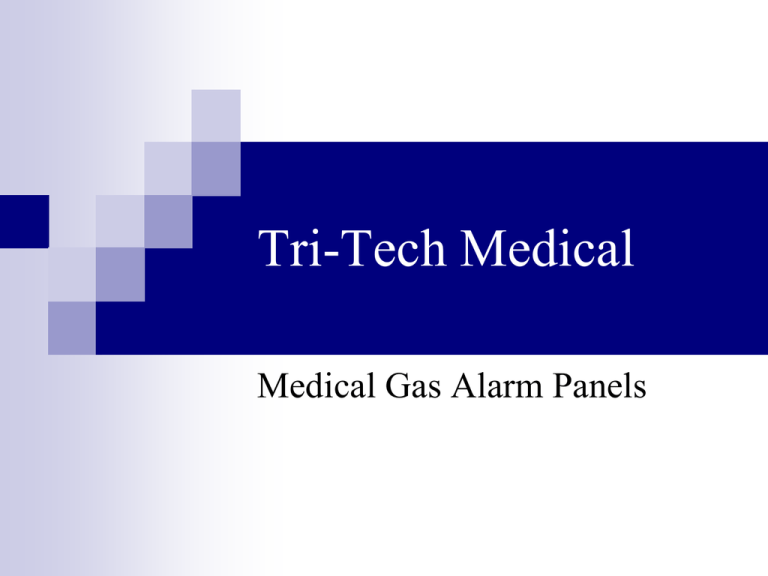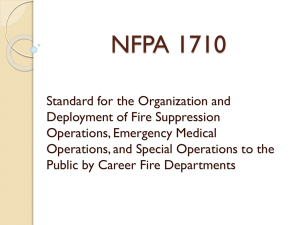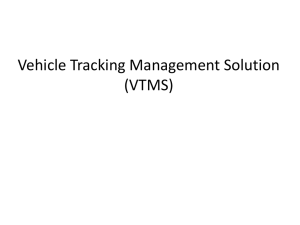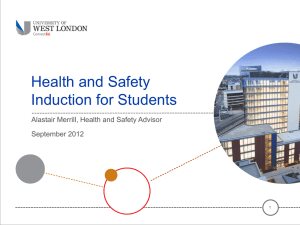DU DC Alarm Presentation - Tri
advertisement

Tri-Tech Medical Medical Gas Alarm Panels Types of Medical Gas Alarms Master Area Combination DU/DC Series Area Alarms Master alarms monitor the ‘trunk’ source equipment Area alarms monitor the ‘branches’ zones or areas – typically downstream of zone valve boxes DU/DC Series Area Alarms Up to 3 gas modules in each vertical slot Up to 14 gas modules in one alarm panel Compact design! Tri-Tech Medical Inc. Medical Gas Master Alarms DU/DC Series Alarms Up to 64 master signal points per panel 16 master signal points per slot Positive confirmation of normal condition (green LED’s) DU/DC Series Alarms Combination 2 gas area + 16 signal master + blank slot for future expansion DU/DC Series Alarms Digital transducers may be mounted in the alarm back box or remotely up to 5,000 feet. Twisted pair ‘fool-proof’ wiring Designed to mount in a standard 2 gang electrical enclosure for added protection Gas specific electronic recognition DU/DC Series Alarms Designed to mount in a standard 2 gang electrical enclosure for added protection DU/DC Series Alarms Designed to mount in a standard 2 gang electrical enclosure for added protection DU/DC Series Area Alarms 2 slot = maximum of 4 transducers 3 slot = maximum of 6 transducers 5 slot = maximum of 9 transducers DU/DC Series Alarms User interface buttons Silence Test Display history Clear history Display high set points ↑ Display low set points ↓ Display gas service → Display transducer type ← DU/DC Series Alarms Gas module displays pressure in .5 psi increments Constant monitoring and positive ‘Normal’ indication Alarms for ‘High’ and ‘Low line pressure. Range from 0.5 psi to 99.5 psi (ideal for lab & hyperbaric applications too!) Alarms for ‘Programming’ and /or ‘System’ error Pockets in label provide protected label slot for the area being monitored Do not require re-calibration Calibration may be adjusted using program keys (by one person) DU/DC Series Alarms 16 master signal points per vertical slot Constant monitoring of normal condition Each point is individually programmable; green, red or may be disabled – factory preset as red with NO Senses & displays NC or NO circuits Pocket in label provides protected label slot for the signal being monitored Pre-printed label sheet is provided DU/DC Series Alarms Up to 64 master signal points per panel 16 master signal points per slot Positive confirmation of normal condition (green LED’s) DU/DC Series Alarms Pocket in label provides protected label slot for the signal being monitored DU/DC Series Alarms Pocket in label provides protected label slot for the signal being monitored DU/DC Series Alarms Button module circuit board Alarm notification remote dry connectors Dip switch for buzzer decibel loudness setting 70, 80 or 90 db. T-Net interface connection Programming button keys (front side) DU/DC Series Alarms Master module circuit board Building management interface boards (MCP boards) Dip switch for programming or run mode 3 character 7 segment display for easy programming DU/DC Series Alarms Gas module circuit board Transducer connectors Low line pressure remote dry connectors High line pressure remote dry connectors Dip switch for programming or run mode DU/DC Series Alarms Low line pressure remote dry connectors High line pressure remote dry connectors Orange & blue = line pressure low Red & green = line pressure high T-Net Medical Gas Alarms Information Management System DU/DC Series Alarms Ethernet interface board, bracket & ribbon cable DU/DC Series Alarms Wireless interface board, antennae, bracket & ribbon cable Thank You NFPA 5.1.9 Level 1 Warning Systems All master, area & local alarm systems used for medical gas & vacuum systems shall include the following: Separate visual indicators for each condition monitored (except as permitted in 5.1.9.5.2) Visual indicators that remain in alarm until the situation that had caused the alarm is resolved A cancelable audible indication of each alarm condition that produces a sound with a minimum of 80 dBA @ 3 ft A means to visually indicate a lamp or LED failure Visual & audible indication that the wiring to an alarm initiating device is disconnected Labeling of each indicator, indicating the condition monitored Labeling of each alarm panel for its area of surveillance NFPA 5.1.9 Level 1 Warning Systems Re-initiation of the audible signal if another alarm condition occurs while the audible alarm is silenced Powered by the Life Safety branch of the emergency electrical system Power for local alarms, dew point sensors, & CO sensors permitted to be from the same essential electrical branch as is used to power the air compressor Wiring from switches or sensors that is supervised or protected as required by Sect 517.30 (C) (3) of NFPA 70 Assurance by the responsible authority of the facility that the labeling of the alarms, where room #’s or designations are used, is accurate & up-to-date Provisions for automatic restart after a power loss of 10 seconds without giving false signals or requiring manual reset NFPA 5.1.9.2 Master Alarms A master alarm system shall be provided to monitor the operation and condition of the source supply, the reserve source, and the pressure in the main lines of each medical gas & vacuum piping system The master alarm system shall consist of two or more alarm panels located in at least two separate locations as follows: One master alarm panel shall be located in the office or work space of the on-site individual responsible for the maintenance of the medical gas & vacuum systems The second master alarm panel shall be located in an area of continuous observation 5.1.9.2.2 A centralized computer system shall be permitted to be substituted for one of the master alarms, if it complies with 5.1.9.4 5.1.9.2.3 The master alarm panels shall connect directly to the alarm devices they monitor 5.1.9.2.3.1 Master alarm signals shall not be relayed from one master alarm panel to another 5.1.9.2.3.2 Where multi-pole alarm relays are used to isolate the alarm initiating signals to master alarm panels, the control power source for the relays shall be independent of any of the master alarm panels 5.1.9.2.3.3 Multiple master alarms shall be permitted to monitor a single initiating device 5.1.9.2.4 Master alarm panels for medical gas & vacuum systems shall each include the following signals: An alarm indication when the medical-surgical vacuum pressure in the main line of each vacuum system drops to or below 300 mm (12 inHg) An alarm indication(s) from the local alarm panel(s) as described in 5.1.9.5.2 to indicate when one or more of the conditions being monitored at a site is in alarm A medical air dew point high alarm from each compressor site to indicate when the line pressure dew point is greater than ± 2° C (+35° F) A WAGD low alarm when the WAGD vacuum level or flow is below effective operating limits An instrument air dew point high alarm from each compressor site to indicate when the line pressure dew point is greater than -30°C (-22°F) 5.1.9.2.4 Master alarm panels for medical gas & vacuum systems shall each include the following signals: An alarm indication for cylinder reserve pressure low when the content of a cylinder reserve header is reduced below one day’s supply For bulk cryogenic liquid systems, an alarm when or at a predetermined set point before the reserve supply contents fall to one day’s average supply, indicating reserve low Where a cryogenic liquid storage is used as a reserve for a bulk supply system, an alarm indication when the gas pressure available in the reserve unit is below that required for the medical gas system to function An alarm indication when the pressure in the main line of each separate medical gas system increases 20 % or decreases 20% from the normal operating pressure 5.1.9.2.4 Master alarm panels for medical gas & vacuum systems shall each include the following signals: An alarm condition when or just before changeover occurs in a medical gas system that is supplied by a manifold or other alternating-type bulk system that has as a part of its normal operation a changeover from one portion of the operating supply to another An alarm indication for a bulk cryogenic liquid system when the main supply reaches an average day’s supply, indicating low contents An alarm indication when or just before the changeover to the reserve supply occurs in a medical gas system that consists of one or more units that continuously supply the piping system while another unit remains as the reserve supply & operates only in the case of an emergency 5.1.9.2.5 The alarm indications required in 5.1.9.2.4(7) and 5.1.9.2.4(8) shall originate from sensors installed in the main lines immediately downstream of the source valves. Where it is necessary to install a main line valve in addition to a source valve, the sensors shall be located downstream of the main valve. NFPA 5.1.9.3 Area Alarms Area alarm panels shall be provided to monitor all medical gas, medical-surgical vacuum, and piped WAGD systems supplying anesthetizing locations, and other vital life support and critical areas 5.1.9.3.1 Area alarms shall be located at a nurse’s station or other similar location that will provide for surveillance 5.1.9.3.4 Sensors for area alarms shall be located as follows: Vital life support & critical areas shall have the alarm sensors installed on the patient or use side of any of the individual zone valve box assemblies Areas for anesthetizing gas delivery shall have the sensors installed either on the source side of any of the individual room zone valve box assemblies or on the patient or use side of each of the individual zone valve assemblies The placement of the sensors shall not be affected by valves located in areas accessible to authorized personnel only, such as service valves. 5.1.9.3.2 Area alarm panels for medical gas systems shall indicate if the pressure in the lines in the area being monitored increases or decreases by 20% from the normal line pressure. 5.1.9.3.3 Area alarm panels for medicalsurgical vacuum systems shall indicate if the vacuum in the area drops to or below 300 mm (12 in Hg).








